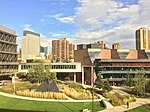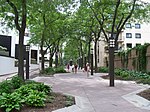Jewish Community Relations Council of Minnesota and the Dakotas
1938 establishments in MinnesotaJewish Community Relations CouncilJewish organizations based in the United StatesJewish organizations established in 1938Jews and Judaism in Minnesota ... and 4 more
Jews and Judaism in North DakotaJews and Judaism in South DakotaNon-profit organizations based in MinnesotaZionist organizations in the United States
The Jewish Community Relations Council of Minnesota and the Dakotas is an organization dedicated to serving as the public affairs voice of the local Jewish communities of Minnesota and the Dakotas. The Jewish Community Relations Council (JCRC) fights anti-Semitism and prejudice, advocates for Israel, provides Holocaust education, promotes tolerance and social justice, and builds bridges across the Jewish and broader communities.
Excerpt from the Wikipedia article Jewish Community Relations Council of Minnesota and the Dakotas (License: CC BY-SA 3.0, Authors).Jewish Community Relations Council of Minnesota and the Dakotas
12th Street North, Minneapolis
Geographical coordinates (GPS) Address Nearby Places Show on map
Geographical coordinates (GPS)
| Latitude | Longitude |
|---|---|
| N 44.975083 ° | E -93.280668 ° |
Address
12th Street North
12th Street North
55402 Minneapolis
Minnesota, United States
Open on Google Maps








